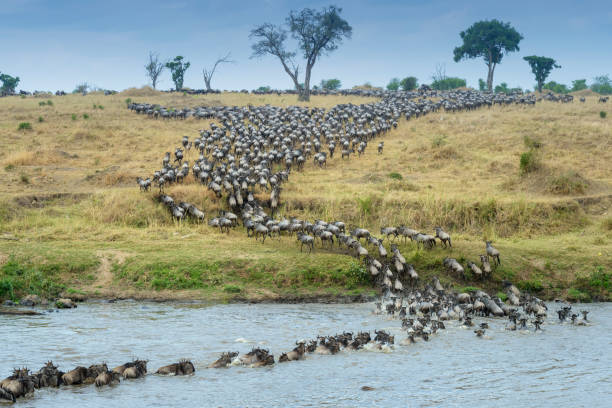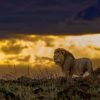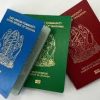The Great Migration is one of the most remarkable natural events in the world, drawing wildlife enthusiasts and researchers alike. Every year, over 1.5 million wildebeest, zebras, and gazelles undertake a continuous journey in search of fresh grazing land, driven by the rains. This extraordinary cycle spans across two countries: Tanzania and Kenya, forming a shared ecosystem known as the Serengeti-Mara. Tanzania’s Serengeti National Park plays a central role in this migration, offering a year-round opportunity to witness different phases of the event.
In this guide, we’ll explore what makes the migration season in Tanzania unique, compare it with neighboring countries’ wildlife spectacles, and provide practical information for planning a migration safari.
What is the Migration Season?
The Great Migration refers to the annual movement of vast herds of wildebeest, zebras, and gazelles across the Serengeti-Mara ecosystem. This natural phenomenon is driven by seasonal rainfall, which dictates the availability of fresh grass. The cycle is continuous, with no definitive start or end, but it can be broken down into key phases based on the herds’ location and behavior.
Key Phases of the Migration in Tanzania
- Calving Season (January – March)
- Location: Southern Serengeti and Ndutu region.
- During this period, thousands of calves are born, creating an abundant food source for predators such as lions, cheetahs, and hyenas.
- Photographers flock to the area to capture the tender moments of new life and dramatic predator-prey interactions.

- Movement Towards the Western Corridor (April – June)
- The herds begin moving northwest, following the rains and fresh grass towards the Grumeti River.
- The Grumeti River crossings, while less famous than the Mara River crossings, are equally thrilling as crocodiles lie in wait.
- Northern Serengeti and Mara River Crossings (July – October)
- By July, the herds reach the northern Serengeti, where they face the perilous Mara River crossings.
- The sight of thousands of wildebeest braving the crocodile-infested river is one of the most iconic moments of the migration.
- Return to Southern Serengeti (October – December)
- As the rains return to the southern Serengeti, so do the herds, completing the annual cycle.
- The plains once again turn green, providing ample grazing for the herds and setting the stage for the next calving season.
The Serengeti’s Central Role in the Great Migration

The Serengeti is at the heart of the Great Migration, hosting the herds for most of the year. Unlike Kenya’s Maasai Mara, where the herds stay for only a few months, the Serengeti offers a year-round migration experience due to its vast size and diverse landscapes.
Unique Features of the Serengeti
- Southern Serengeti Plains: Known for its nutrient-rich grass, this region is the primary calving ground for the herds.
- Western Corridor: This area is home to the Grumeti River, where dramatic river crossings occur.
- Northern Serengeti: Famous for the Mara River crossings and the Lamai Wedge, a less crowded area with excellent wildlife viewing.
The Serengeti’s vastness (14,750 sq km) ensures a more immersive and less crowded experience compared to Kenya’s Maasai Mara (1,500 sq km).
Comparing Tanzania’s Migration to Neighboring Countries
While the Serengeti-Mara ecosystem is shared by Tanzania and Kenya, other neighboring countries also offer unique wildlife experiences. Here’s how they compare:
A. Kenya’s Maasai Mara
- Shared Ecosystem
- The Maasai Mara is an extension of Tanzania’s Serengeti, with the herds crossing into Kenya from July to October.
- The Mara River crossings in Kenya are world-famous, attracting large numbers of tourists.
- Key Differences
- The Maasai Mara hosts the migration for a shorter period (3-4 months), while Tanzania offers year-round opportunities.
- Due to its smaller size, the Maasai Mara tends to be more crowded during peak migration season.
B. Uganda and Rwanda

While Uganda and Rwanda don’t host the Great Migration, they offer complementary wildlife experiences:
- Gorilla Trekking
- Both countries are renowned for mountain gorilla trekking in Bwindi Impenetrable National Park (Uganda) and Volcanoes National Park (Rwanda).
- Combined Safari Options
- A migration safari in Tanzania combined with gorilla trekking in Uganda or Rwanda provides a diverse East African wildlife adventure.
C. Zambia’s Wildebeest Migration
- Zambia’s Liuwa Plains National Park hosts a smaller wildebeest migration, involving tens of thousands of animals.
- While impressive, it’s much smaller in scale compared to the Serengeti’s migration.
D. Botswana’s Zebra Migration
- Botswana’s Makgadikgadi Pans is home to Africa’s largest zebra migration.
- Unlike the Serengeti’s continuous cycle, Botswana’s migration is seasonal, driven by the Okavango Delta’s flood cycles.
Why Tanzania Stands Out
- Year-Round Migration Experience
- Unlike Kenya, where the migration is seasonal, Tanzania offers a migration experience throughout the year.
- Unique phases such as the calving season and Grumeti River crossings are exclusive to Tanzania.

- Vast and Diverse Ecosystem
- The Serengeti’s vast size ensures a more private and immersive experience.
- The park’s diverse landscapes include open plains, riverine woodlands, and granite kopjes.
- Exclusive Safari Activities
- Mobile Camping: Luxury mobile camps follow the herds, offering front-row seats to the migration.
- Balloon Safaris: Aerial views of the herds provide a unique perspective.
- Walking Safaris: Certain Serengeti regions offer walking safaris, providing a closer connection to nature.
Unique Facts About the Great Migration
- Longest overland migration: The herds travel over 1,000 kilometers annually.
- Massive scale: Over 1.5 million wildebeest, 400,000 zebras, and 200,000 gazelles take part in the migration.
- High survival rate: Despite numerous predators and river crossings, the sheer number of animals ensures the continuation of the species.
Practical Tips for Planning a Migration Safari
- Book Early: Migration safaris are in high demand, especially during peak phases.
- Pack Smart: Bring neutral-colored clothing, binoculars, and a high-quality camera.
- Stay Flexible: The migration’s timing depends on rainfall, so flexibility in your travel dates can enhance your experience.
- Choose Experienced Guides: Local guides can track the herds and provide the best viewing opportunities.
Conclusion
Tanzania’s Serengeti offers an unparalleled Great Migration experience, with year-round opportunities to witness different phases of this natural spectacle. While neighboring countries like Kenya, Uganda, Rwanda, Zambia, and Botswana offer unique wildlife encounters, none match the scale and diversity of Tanzania’s migration. By planning carefully and choosing the right safari route, visitors can immerse themselves in one of nature’s greatest spectacles and gain a deeper appreciation for the interconnectedness of life on Earth.




